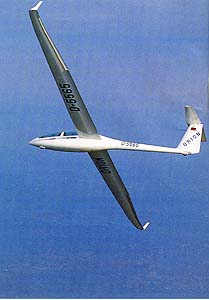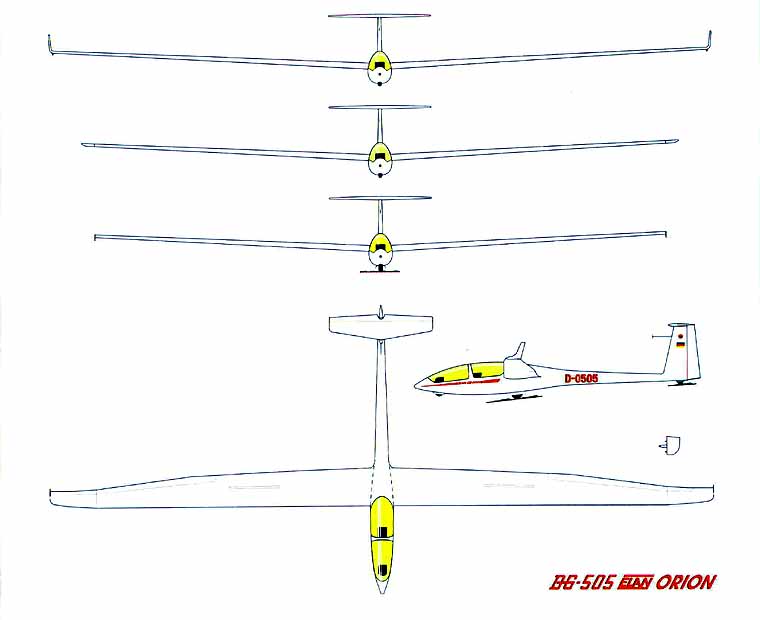DG Flugzeugbau offers the equivalent of three Two-Seaters with the DG-505 Elan ORION. The further development of the DG-500 trainer with 20 m wingspan brings enhanced performance for use in the Two-Seater Class.
 The most obvious characteristic of the ORION is it’s great variability in wingspan. On one hand it can be used in it’s 17.2 m version for aerobatics or initial training, and on the other hand the wing extensions to 20 m makes full use of the wingspan limits set for the Two-Seater Class. The enhanced L/D (44) with the larger wing adds to the pleasures of cross country soaring. With the optional tip extensions to 18 m the ORION resembles the well-known trainer, but with many improvements in the details. In this configuration with fixed (non-flapped) wings this two-seater is best suited for training.
The most obvious characteristic of the ORION is it’s great variability in wingspan. On one hand it can be used in it’s 17.2 m version for aerobatics or initial training, and on the other hand the wing extensions to 20 m makes full use of the wingspan limits set for the Two-Seater Class. The enhanced L/D (44) with the larger wing adds to the pleasures of cross country soaring. With the optional tip extensions to 18 m the ORION resembles the well-known trainer, but with many improvements in the details. In this configuration with fixed (non-flapped) wings this two-seater is best suited for training.
With the three ORION variants do not reach the limits of the DG-505 series. For the demands the ORION cannot quite satisfy there is a parallel series of DG-505 versions with flapped wings: the DG-505/20 with winglets, and the DG-505 with 22 m wings as Motor Glider with retractable propeller. The fuselage is the same as the non-flapped versions. Only the rudder is slightly different, with higher ground clearance on the bottom.
For this report the ORION 20 m version, newly approved by the LBA (German Air Ministry) was available. It has the greatest variation from the previous basic DG-500. It differs from the DG-500/20 with winglets presented in the “Aerokurier” 10/94 by having a fixed (non-flapped) wing, which now has zigzag tape on the underside of the wing for enhanced laminar flow control. A marked difference can be seen in the wing configuration. In the ORION the 1.4 m wing extensions do not follow the forward line of the trailing edge, but instead actually reverse rearward. Optically this creates the illusion that the outer wing points rearward, similar to the wing tip feathers of birds.
This wing geometry avoids too much of a pointed wing tip, so that even this part of the wing operates within reasonable Reynolds numbers. The aspect ratio, so important for thermalling, increases from 19.5 for the trainer to 22.7. The increase in wing area is exactly one square meter, which benefits the minimal wing loading for a small increase in weight (10 kg).
The increased wingspan aims at ambitious cross country soaring even more than the trainer. To maximize the capabilities there is a water ballast system (160 lt.) in the wings, as well as two tail fin tanks to balance the C.G. One of these tanks (12 lt.) specifically corrects the C.G movement cause by the second pilot, and functions independently from the main ballast system.
For aerodynamic efficiency the main large, sprung main wheel (380×140 mm) is retractable. Only the small front wheel and the tail wheel protrude. Thanks to the large main wheel the ORION can be handled even on soft ground in spite of it’s 410 kg weight.
For rigging or derigging three people and one wing stand are sufficient, but as usual with large sailplanes some effort is involved. The 1.60 m long wing extensions with integrated winglets can be handled by one person by inserting the extension spar into the proper tunnel in the main wing. Pins secure the aileron extension into the wing extension. In the fuselage all connections are automatic. The elevator connection is only possible in the correct attitude, with two men setting the elevator in the rather high (1,82 m) tail fin. Locking is conveniently through the tail fin.
There are some changes in the cockpit of the 505 as compared to the 500 which enhance both passive security and comfort. There are now headrests for both pilots based on the latest research. There is more room in the front seat. The rudder pedal adjustment has more range, which will benefit both smaller and larger pilots. The front stick coupling is higher, so that full side movements no longer conflict with pilots’ thighs.
The control stick in the back seat is longer by 35 mm. The panel has a higher bottom, is equipped with a map pocket and now has enough room to remove the feet from the rudder pedal and relax. Behind the back seat there is an enlarged baggage compartment (except in the Motor Glider version).
The DG-505 becomes visible as the latest model in a series by it’s new, fresh design of the interior cloth, which continues the line from the DG-303.

For aero tow the nose hook is used and is standard equipment in the ORION. Tethered like this, the two-seater follows the tow plane in a docile manner. The grass runway at Linkenheim is fairly well soaked due to the late fall weather so that the ground roll is fairly long, but due to the large diameter wheel the ORION does not sink in very much. Operation from all field is therefore possible, not only from paved runways. And for off field landing this is also an advantage.
Visibility from the front seat is excellent. From the back seat the head of the front seat pilot restricts visibility somewhat, a common problem in all two seaters. But the head rest is proportioned in such a way as to cause only a minor problem. The tow plane remains visible because of the slightly raised back seat.
The landing gear can be retracted while still on tow. As in the almost identical cockpit layout of the single seaters, the retract lever is located on the left side of the cockpit, which avoids switching hands. Partly using the unlocking force a single coordinated movement needs little force to extend or retract the gear.
On a late fall November day the ORION remains stable after release, both in straight and banked flight in the stable air mass between Pfälzer Wald and “Black Forest”. Small self-induced disturbances cause no problems.
The trim of the ORION is effective over the whole speed range. The quick-trim with the release button on the stick needs a bit of manual help with the indicator on the left side of the cockpit. But the desired speed is easily adjusted.
Statically the DG-505 ORION is very stable. Stick forces increase, as they should, with increased speed. Dynamically it shows a tendency to increase the roll moment, which gives it very pleasant handling characteristics. Speed increases rapidly. But the disadvantage of a non-flapped wing cannot be ignored, and at the higher speed ranges the nose points distinctly under the horizon.
The stall characteristics are docile, as they should be in a trainer. With steady, slow decrease of airspeed and C.G centered the two seater can’t be induced to drop a wing, either in straight of banked flight. The nose points to high above the horizon, the ailerons become soft and as it transits to almost stalled flight slight shaking can be felt as the airspeed increases slightly. In this condition the ORION can be controlled with slight aileron and rudder inputs even when the stick is in full back position. Only when airspeed is abruptly reduced does it break straight ahead, but with relaxation of the stick the stall can be broken with a minimum of height loss.
In thermalling mode with some deliberate centering corrections the 20 m sailplane shows that there is good coordination in ailerons and rudder with reasonable stick forces (unfortunately there were no thermals). This is not quite true when initiating a turn. The large rudder input is required. For thermalling corrections such as less or more bank, often required in thermal flight, the required rudder input is less noticeable. Overall the ORION follows the rudder input quite well in spite of it’s 20 m wing span.
Thanks to the winglets the DG-505 ORION can be flown quite slowly relative to stall speed and at reasonable bank attitude.
The ORION gives the impression of a quite useful and agile sailplane for it’s wing span. Curiously the 20 m wingspan in a two seater appears less imposing than the 18 m span in a single seater, so that in the ORION cockpit one hardly notices that this is a large sailplane. Naturally the bank left to bank right times are higher that in a 15 m single seater.
Landing the ORION is easy for the pilot. With extended gear and full dive brakes (Schempp-Hirth brakes on the upper wing surface) a sink rate of more than 5 m/s is achieved. Extending the dive brakes results in a slight airspeed increase, unless corrective action is taken. Side slips are also possible.
Unfortunately is was not possible, (because of the November conditions) to test out the cruise behavior with the increased wing span. The factory claim of an increase of 4 points over the 18 m version (Trainer) should make itself felt in good weather conditions. This would be a relative improvement of about 10 %. In any case, with the increased wing span the ORION offers an attractive alternative to the Trainer version. It offers attractive performance without increasing the pilot work load, since there are no flaps. And the possibility of varying the wing span it can be optimized for the various intended uses such as beginner training, aerobatics and cross country soaring.
Gerhard Marzinzik
reprinted from the “Aerokurier” 1/96 with the kind permission of the author.
translated by Albin Schreiter, CDN


